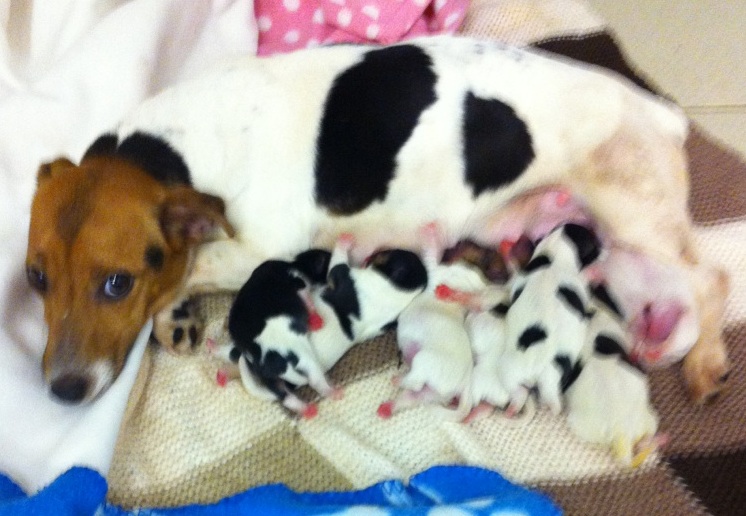Welcome to Ethical Business: Ethical Life – we aim to showcase the people behind the amazing Ethical Businesses we meet through running Ethical Pets.This second edition is about our friends at Riverflow Clothing: they live on a beautiful red boat and sell fair trade clothes at affordable prices – it’s hard not to like them! Riverflow are a family of four and a half: there is Miriam, Matt and then Caleb and Flynn (5 ½ year old twins) and a bump on the way, due in April! They also live with their dog called Ella, who they rescued from from Birmingham Dogs Home. Ella was a “death row dog” – due to be put down the very next day. Thank goodness for Riverflow eh?!
to showcase the people behind the amazing Ethical Businesses we meet through running Ethical Pets.This second edition is about our friends at Riverflow Clothing: they live on a beautiful red boat and sell fair trade clothes at affordable prices – it’s hard not to like them! Riverflow are a family of four and a half: there is Miriam, Matt and then Caleb and Flynn (5 ½ year old twins) and a bump on the way, due in April! They also live with their dog called Ella, who they rescued from from Birmingham Dogs Home. Ella was a “death row dog” – due to be put down the very next day. Thank goodness for Riverflow eh?!
Why did you set up Riverflow Clothing?
We’ve both worked jobs before that have either involved lining someone else’s, already very well lined, pockets or compromising our beliefs. Or both. So, Riverflow Clothing was born out of a desire to work for ourselves and to earn our money in a way that didn’t compromise our ethics and values. We don’t want to make money at the expense of others or the environment, so we try to ensure our business has the minimum negative impact possible. Everything we sell is fairly traded and ethically sourced, and our packaging is biodegradable or compostable too!
We get our stock by buying up samples, previous season and end of line stock from several fair trade importers, which means we can pass on the saving we make by offering everything at prices we’d be prepared to pay ourselves. Also, pretty much everything we stock is unique; it’s rare we have 2 of the same item.
 When did you set up and how did it go?
When did you set up and how did it go?
We set up just over a year ago. Matt was working full time so we sold at the odd event here and there to test the water. It was a slow and sometimes disheartening start. There were a lot of initial expenses, aside from the stock itself and rails etc, we’ve had to buy a box trailer to store everything and a stall frame for outdoor events. It’s also always a gamble booking new events, sometimes you pay a hefty stall fee and footfall is really low or it’s just the wrong sort of event. We made a few bad choices to start with but then, we had a stall at a local music festival in the summer and did really well which was a massive confidence boost. Since then we’ve been more selective about which events we book and have found it’s well worth traveling a distance for the right events.
Do you enjoy your work?
When we have a stall at an ethical event, it doesn’t feel like working: we get to spend the day together as a family and meet a whole bunch of lovely people. We’re definitely on the look out for more of those this year.
Riverflow is not the only work we do however. Miriam works a couple of days a week in a local charity shop and Matt has does some freelance website design. We’re not into profit yet with the clothing and don’t know if we’ll ever make enough to li ve on it exclusively – but we’ve grown a lot in a year though and feel like we’ve got a better idea of what we’re doing now!
ve on it exclusively – but we’ve grown a lot in a year though and feel like we’ve got a better idea of what we’re doing now!
Describe an average day in the life of you.
The most important thing to us is our family. We try to spend as much time together as possible – something that doing events allows. Do we have an unusual lifestyle? We’re a home educating, vegan, TV free, co-sleeping, attachment parenting, nomadic, live-a-board family. Whether that’s unusual depends on your perspective, but I guess to most people it probably is.
An average day? There isn’t one! As much as possible we try to make sure one of us is available to spend time exclusively with/on the boys. What we’re doing though varies day to day and depends on so much. Matt works mostly from home but Miri is in a different couple of days at the charity shop each week. There are home ed. groups we go to. We have stalls at events. There are lots of chores living on a boat too, so we might have to move the boat to fill  with water or fuel, take washing to the launderette, visit the builders merchant for a new gas bottle or take recycling and rubbish to the tip. This time of year there’s always wood to fetch and cut. Never appreciated the phrase “there’s not enough hours in the day” as a kid but can completely relate to it now!
with water or fuel, take washing to the launderette, visit the builders merchant for a new gas bottle or take recycling and rubbish to the tip. This time of year there’s always wood to fetch and cut. Never appreciated the phrase “there’s not enough hours in the day” as a kid but can completely relate to it now!
What are your ethical principles and how do they guide and motivate you?
We try to have the biggest positive impact and smallest negative impact that we can in everything we do. We don’t really subscribe to any particular set of beliefs as is but veganism, sustainability, fair trade, permaculture, unschooling, attachment parenting, non aggression principle, libertarianism, anarchy and volintarism all come into it somewhere along the way.
We’re fortunate to know a whole bunch of lovely people from different backgrounds and with massively different lifestyles and beliefs. It often makes for interesting conversations and ones that challenge, or make you reaffirm, what you think and do.
Any words of wisdom?
‘Anything is slavery if it isn’t in your heart’
Inner Terrestrials – Thirty Pieces

 Last month was all about speed: this month we are looking at size and longevity. So, which are the heaviest and longest living animals?
Last month was all about speed: this month we are looking at size and longevity. So, which are the heaviest and longest living animals?















